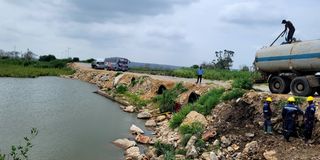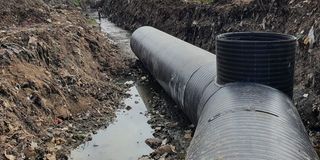Weholite in building the future by transforming water management infrastructure

The DN2000 HDPE Weholite Culverts installed at Somanga bridge restoring access for economic activities to resume.
Providing and maintaining safe water management systems cannot happen without new investment and human technical capacity, particularly considering the growing population density in urban centres of Tanzania.
Solutions such as use of Weholite HDPE structured wall pipe systems offer long term remedies to the stormwater management problems that seem to bedevil most urban sites, poorly planned residential areas and the wider transportation network throughout the country.
Weholite HDPE structured wall pipe systems, manufactured by Megapipes Solutions Limited, at their world class factory in Kigamboni, Dar es Salaam, are providing sustainable alternatives for solving Tanzania’s flooding and water management challenges, according to engineers implementing infrastructure projects.
Transport Infrastructure
Tanzania’s road and rail networks are expanding rapidly, driven by economic growth and the need for efficient transport systems, and that makes Weholite culverts ideal for road construction because they are corrosion and abrasion resistant, easy to install and have a service life in excess of 100 years.
TANROADS are pioneering the use of this technology, because the durable nature of Weholite culverts have increased efficiency with minimal disruptions. Highway construction is not only a means of building a surface to carry vehicles, but in many cases, provides a lifeline to the local communities.
A recent example of this innovative philosophy occurred in Somanga village, Lindi region, where a critical highway connecting Dar es Salaam, Lindi, and Mtwara was severely impacted when El Niño floods washed away a vital bridge in May 2024. This bridge served as a crucial artery for vehicles and trucks engaged in road freight, facilitating trade and movement across regions.
The disruption had significant economic ramifications, hindering transport and delaying deliveries for local businesses. However, drawing on their previous successful installations of Weholite culverts, TANROADS swiftly opted to utilize DN2000 Weholite Culverts to rebuild the bridge.
This decision ensured that access was restored in record time, minimizing inconvenience to the community and allowing economic activities to resume quickly.
Structures buried under the surface of the roads need to have unique properties to withstand the continual dynamic pressures of heavy traffic passing on the road above.
Weholite pipes are designed specifically with this in mind. The culverts do not need concrete surround and are backfilled using the excavated good quality soil. Headwalls will be fitted at either end to ensure that soil doesn’t erode which will also help to ensure that the road is not destroyed when there are flash floods.
Weholite culverts are durable and efficient in ensuring water is channelled properly so that traffic can flow without disruptions. Additionally, the lightweight construction of Weholite culverts enable quick installation, get traffic moving with minimal disruptions, sometimes in hours and are durable and environmentally friendly. The culverts are easily transported without any breakages unlike their concrete equivalents, this is the future of road construction.

The DN1800 HDPE Weholite Pipe with access shaft installed at Chato Street Dar es Salaam.
Urban Drainage
Taking a tour along the roads of some densely populated areas in Tanzanian cities and there is usually one common feature, open drainage channels. These are mostly found in urbanised areas and used for the discharge of rainwater, especially during storms. Rainwater collected by these channels is often directed to rivers or other water courses.
The construction of exposed drainage systems is a culture that has been sustained over the decades. Dar es Salaam is prone to flooding, and it is also a place that is supremely notorious for blocked drainage systems. The poor condition of many streets for instance, is attributable to the construction of open drainage systems.
Drains are meant to serve a good purpose in helping to prevent flooding, however, when they are left open, solid waste can collect in them and lead to blockages and clogging resulting in floods that in turn destroy roads.
The rate of road deterioration increases with an increase in granular moisture content and there seems to be no recognition that open drains use land, which means that there are no pavements or walkways for pedestrians, often forcing them onto the roads and placing them in danger of being hit by motorists.
It is therefore vital to take positive action to save lives and the billions of shillings spent due to ailments and the destruction caused by open drainage channels.
Designing and constructing drainage systems require expert advice from engineers to make sure that water flows away efficiently and safely and is disposed of in a surface watercourse or soakaway. Drainage installed by one community should not create problems for other communities downstream, nor should it affect ecologically important sites.
Weholite Stormwater solutions are providing sustainable alternatives for solving Dar es Salaam’s flooding challenges, according to engineers implementing the city’s water management infrastructure projects.
Weholite is available in diameters from DN/ID 350 to DN/ID 3000, which make them ideal for channelling large volumes of water away from troubled areas thus providing much needed flood relief to the residents.
Megapipes recently supplied around 300m of DN1800 Weholite Pipes, for a major flood relief project in Chato Road, Dar es Salaam. The system included custom built intersections and access shafts, which offer long-term solutions to the urban flooding menace.
Implementing stormwater management systems in a large city is an arduous but not an insurmountable task thanks to Weholite solutions which are solving some of our engineering challenges.
Some of these challenges include putting up infrastructure in a way that minimally disrupts the livelihoods of Dar es Salaam’s 6 million residents. Weholite pipes are much lighter than concrete equivalents which makes transporting and handling them not only faster but cheaper and safer.
Weholite lends itself to stormwater drainage systems such as the one installed in Chato Road, due to its versatility and ability to be fabricated easily into complex arrangements that otherwise would be extremely difficult to build using traditional methods. This is a key attribute when the system must navigate around densely populated urban areas and a multitude of other services that are below ground.
An added bonus is that Megapipes was able to assemble and test prefabricated sections at their factory in Kigamboni, Dar es Salaam minimising the installation time on site and increasing the confidence of the customer. Additionally, solid waste is safely handled through the superior hydraulics and the closed sewers unlike open drainage channels.
The Chato Road Project, implemented by TARURA Kinondoni is expected to improve the lives of Dar es Salaam residents who are perennially affected by floods. Currently, floods directly and indirectly affect two out of five Dar es Salaam residents or close to two million people with different levels of intensity.
This new innovative solution brings great value to the residents of Dar es Salaam, as it is locally manufactured and proven technology, which has been used globally in South Africa, Europe, and North America
The future of water management
Weholite HDPE pipes and systems, can be customised to fit efficiently into the built environment, or similarly utilised for quick construction of transport infrastructure on main highways, for urban roads or in a rural setting; thus, relieving engineers of the challenge that comes with installing infrastructure across Tanzania. Disruption to lives and livelihoods is one of the main reasons communities often resist new projects, which is not an issue when using Weholite.
All of this suggests that this technology should be explored for its potential to roll-out this new infrastructure in such a fast and efficient way.


